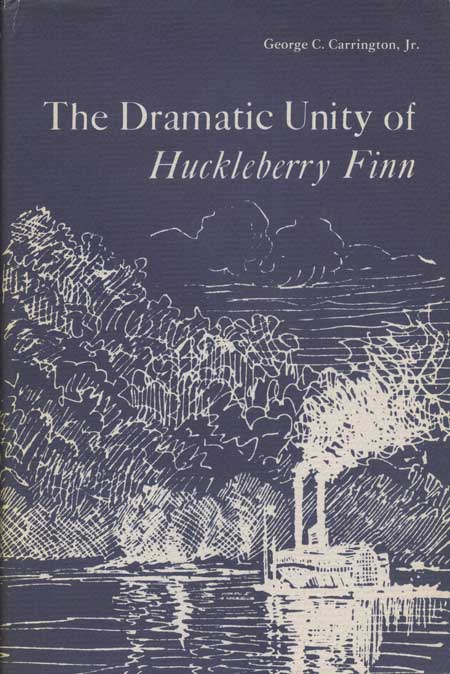| click here to read the complete text of the book | leave / read comments and critiques of the book |

The Dramatic Unity of Huckleberry Finn
George C. Carrington, Jr.
Mark Twain’s Adventures of Huckleberry Finn has, with The Scarlet Letter and Moby-Dick, been generally acknowledged as one of the three authentic masterpieces of American fiction. But unlike the other two, whose weaknesses are judged minor and incidental, Twain’s greatest book has been regarded by able and thoughtful critics as an imperfect, indeed radically flawed work of genius.
Professor Carrington’s probing and incisive study of the novel that has been declared one of our national treasures throws abundant new light on the problem that has long vexed readers and critics alike: Does the ending belong to the book? Is our national treasure and “great American novel” deserving of these accolades only if its substance and structure are diminished by one-fourth?
The hundreds of books and articles that have been written on Huckleberry Finn have failed to resolve this conundrum, though most authorities have sharply criticized the novel’s ending and found it expendable. Unable to reconcile the abrupt shift in mood from the quiet dignity of Huck’s reverie in chapter 31 to the interminable, thoroughly outrageous, but nonetheless hilarious buffooneries of the final chapters, most critics and scholars have simply dismissed the novel’s close as unrestrained improvisation and “extended burlesque.” A version has even been published that omits the concluding and offending chapters.
It is Mr. Carrington’s position that, though Twain most certainly did write improvisation, he did not publish them, and that it is, after all, with the novel as Twain published it that we must deal. To torture the book, as a whole generation of critics have done, on the Procrustean bed of this or that approach currently fashionable in modern intellectual life, and to turn away eventually, in disgust or despair, because the ending simply does not fit the critical scheme, is to make too rigid an application of the rules of generic consistency, with their requirement that a uniformly tragic or comic mood be maintained, and to disregard the disturbing truth contained in the farce at the novel’s end.
We must, Mr. Carrington argues, force ourselves to let the novel present itself—to let incidents and their effects cluster into patterns that ultimately form their own kind of coherent whole and achieve their own effect. And it is this that he attempts to do. He employs a structuralist approach to find, not just order, but the making of order under an apparent disorder and discontinuity, and to discover for us a novel constructed of episodes that lack surface connections but are ineluctably conjoined at a deeper level of structure, where Twainian man struggles to give pattern, stability, and meaning to his world—a novel that, with its ending integral and intact, becomes a gesture of tragic recognition of an American and a human predicament, and of an acceptance of that dilemma, not of its permanence, but of its present and terrible difficulties.
George C. Carrington, Jr. is professor of English at Northern Illinois University and the author of The Immense Complex Drama: The World and Art of the Howells Novel.
| 1976 201 pp. | This title is no longer available in a traditional print edition. Click here for free access to the book’s full text. |

